Financial Resource Management and Decision Making for Business
VerifiedAdded on 2020/01/07
|23
|4299
|194
Report
AI Summary
This report examines the crucial role of financial resources in business operations, focusing on Sainsbury's expansion plans within the competitive UK retail market. It explores various financing sources, including bank loans, share issuance, retained earnings, and asset sales, analyzing their implications on the company. The report emphasizes the importance of financial planning and assesses the information needs of different decision-makers, such as managers, creditors, and the government. It evaluates equity and retained earnings as appropriate sources of finance for Sainsbury, considering the challenges of low-profit margins and the impact of finance on financial statements like the income statement and balance sheet. The report further discusses the main financial statements, including the income statement, balance sheet, and cash flow statement, and compares their formats. Additionally, it delves into ratio analysis, budget analysis, unit cost calculations, and project evaluation techniques such as payback period, ARR, NPV, and IRR to assess the viability of the expansion proposal, providing a comprehensive overview of financial resource management and decision-making processes.
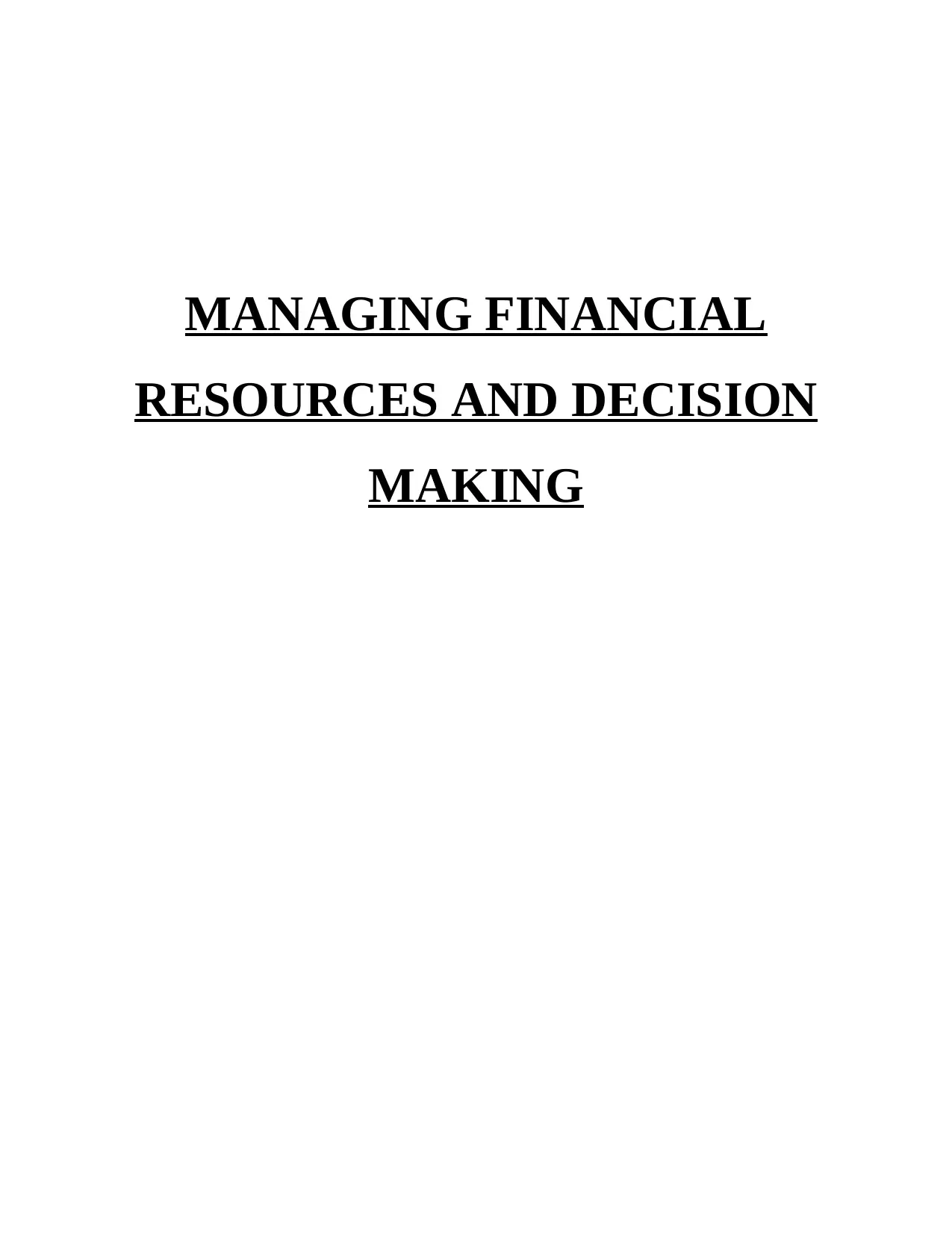
MANAGING FINANCIAL
RESOURCES AND DECISION
MAKING
RESOURCES AND DECISION
MAKING
Paraphrase This Document
Need a fresh take? Get an instant paraphrase of this document with our AI Paraphraser
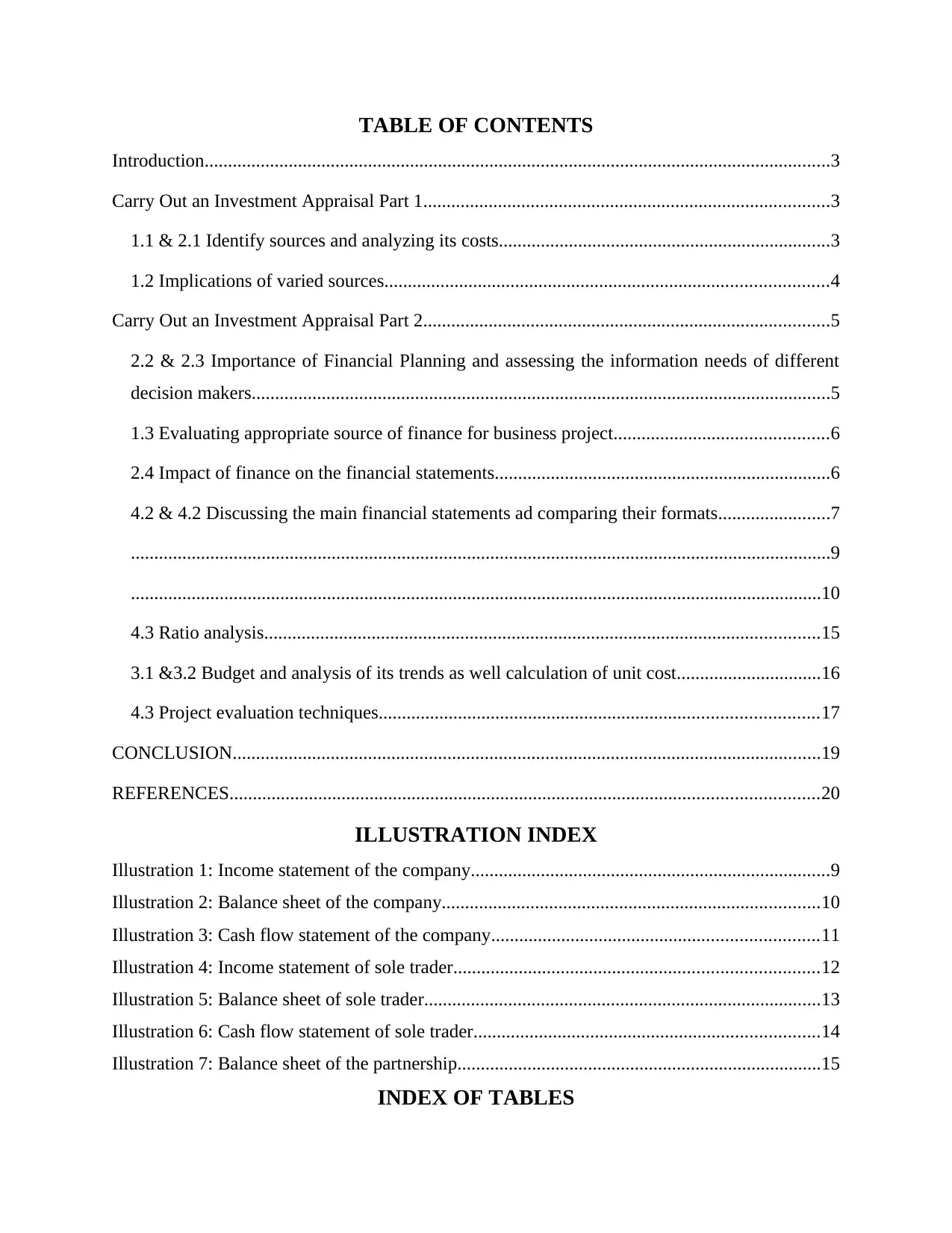
TABLE OF CONTENTS
Introduction......................................................................................................................................3
Carry Out an Investment Appraisal Part 1.......................................................................................3
1.1 & 2.1 Identify sources and analyzing its costs.......................................................................3
1.2 Implications of varied sources...............................................................................................4
Carry Out an Investment Appraisal Part 2.......................................................................................5
2.2 & 2.3 Importance of Financial Planning and assessing the information needs of different
decision makers............................................................................................................................5
1.3 Evaluating appropriate source of finance for business project..............................................6
2.4 Impact of finance on the financial statements........................................................................6
4.2 & 4.2 Discussing the main financial statements ad comparing their formats........................7
......................................................................................................................................................9
....................................................................................................................................................10
4.3 Ratio analysis.......................................................................................................................15
3.1 &3.2 Budget and analysis of its trends as well calculation of unit cost...............................16
4.3 Project evaluation techniques..............................................................................................17
CONCLUSION..............................................................................................................................19
REFERENCES..............................................................................................................................20
ILLUSTRATION INDEX
Illustration 1: Income statement of the company.............................................................................9
Illustration 2: Balance sheet of the company.................................................................................10
Illustration 3: Cash flow statement of the company......................................................................11
Illustration 4: Income statement of sole trader..............................................................................12
Illustration 5: Balance sheet of sole trader.....................................................................................13
Illustration 6: Cash flow statement of sole trader..........................................................................14
Illustration 7: Balance sheet of the partnership..............................................................................15
INDEX OF TABLES
Introduction......................................................................................................................................3
Carry Out an Investment Appraisal Part 1.......................................................................................3
1.1 & 2.1 Identify sources and analyzing its costs.......................................................................3
1.2 Implications of varied sources...............................................................................................4
Carry Out an Investment Appraisal Part 2.......................................................................................5
2.2 & 2.3 Importance of Financial Planning and assessing the information needs of different
decision makers............................................................................................................................5
1.3 Evaluating appropriate source of finance for business project..............................................6
2.4 Impact of finance on the financial statements........................................................................6
4.2 & 4.2 Discussing the main financial statements ad comparing their formats........................7
......................................................................................................................................................9
....................................................................................................................................................10
4.3 Ratio analysis.......................................................................................................................15
3.1 &3.2 Budget and analysis of its trends as well calculation of unit cost...............................16
4.3 Project evaluation techniques..............................................................................................17
CONCLUSION..............................................................................................................................19
REFERENCES..............................................................................................................................20
ILLUSTRATION INDEX
Illustration 1: Income statement of the company.............................................................................9
Illustration 2: Balance sheet of the company.................................................................................10
Illustration 3: Cash flow statement of the company......................................................................11
Illustration 4: Income statement of sole trader..............................................................................12
Illustration 5: Balance sheet of sole trader.....................................................................................13
Illustration 6: Cash flow statement of sole trader..........................................................................14
Illustration 7: Balance sheet of the partnership..............................................................................15
INDEX OF TABLES
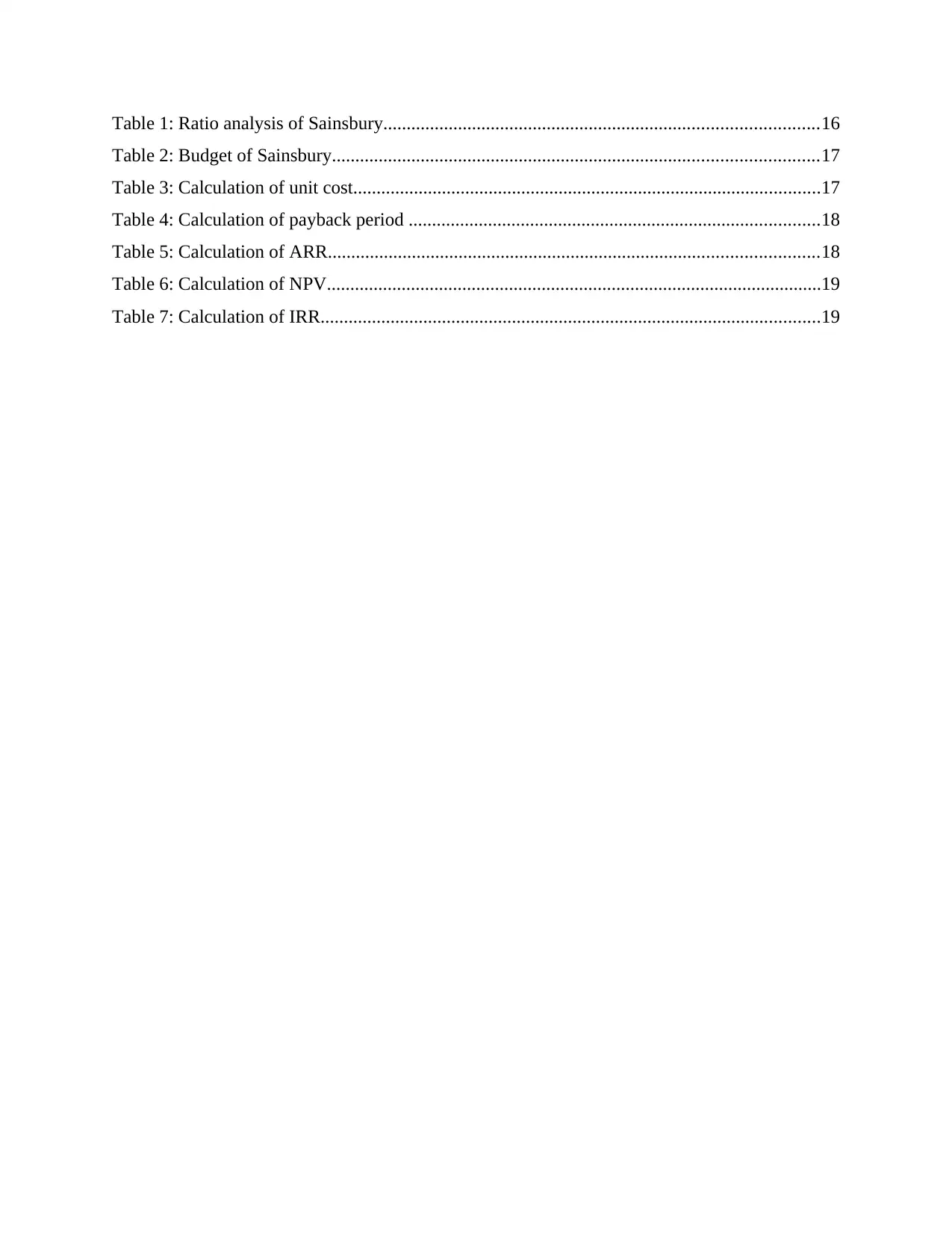
Table 1: Ratio analysis of Sainsbury.............................................................................................16
Table 2: Budget of Sainsbury........................................................................................................17
Table 3: Calculation of unit cost....................................................................................................17
Table 4: Calculation of payback period ........................................................................................18
Table 5: Calculation of ARR.........................................................................................................18
Table 6: Calculation of NPV..........................................................................................................19
Table 7: Calculation of IRR...........................................................................................................19
Table 2: Budget of Sainsbury........................................................................................................17
Table 3: Calculation of unit cost....................................................................................................17
Table 4: Calculation of payback period ........................................................................................18
Table 5: Calculation of ARR.........................................................................................................18
Table 6: Calculation of NPV..........................................................................................................19
Table 7: Calculation of IRR...........................................................................................................19
⊘ This is a preview!⊘
Do you want full access?
Subscribe today to unlock all pages.

Trusted by 1+ million students worldwide

INTRODUCTION
Resources for business enterprises are important because they are the reason behind
better execution of their operational activities. In particular, financial resources play significant
role as company without adequate funds cannot survive in the current competitive market. These
are the basic amenities that help management in carrying out operations of business in effective
and appropriate way. In the present study, researcher focuses on evaluating the importance of
financial resources within a business. Further, it takes into consideration different sources that
are available and their implications to Sainsbury. Operating in retail sector of UK, company has
to face major competition which indeed enforces the management to maintain financial position
to attain long term sustainability. Herein, senior authority of cited firm plans to expand business
thus; it becomes essential to make optimum utilization of available financial resources. Lastly,
through the help of different appraisal techniques, viability of available expansion proposal has
been evaluated so that the best possible decision can be made.
CARRY OUT AN INVESTMENT APPRAISAL PART 1
1.1 & 2.1 Identify sources and analysing its costs
Varied sources of finance are available for top level management of Sainsbury with the
help of which they can easily carry out their expansion process. In general terms, sources of
funds are important for a business as it helps in satisfying their financial needs. These sources are
further bifurcated into two internal and external aspects. Following are the sources of finance
which are available to Sainsbury as follows: Bank Loan: By operating at large level, there are several financial needs that affect the
working of Sainsbury. Thus, borrowing from financial institution is one of the major
external sources that fulfil different prospects. The main advantage of this source is that it
assists in raising huge amount for capital by completing mere formalities (Embrechts,
Klüppelberg and Mikosch, 2013). Further, by considering the brand image of Sainsbury
in target market, there are various financial institutions which are present to provide
money in terms of loan to the company. But negative implication of this source is that
Sainsbury has incurred costs of interest and collateral security in raising the funds. Issue of shares: Being a leading organisation in UK retail industry, it is one of the
prominent sources of raising funds. However, there are two methods through
Resources for business enterprises are important because they are the reason behind
better execution of their operational activities. In particular, financial resources play significant
role as company without adequate funds cannot survive in the current competitive market. These
are the basic amenities that help management in carrying out operations of business in effective
and appropriate way. In the present study, researcher focuses on evaluating the importance of
financial resources within a business. Further, it takes into consideration different sources that
are available and their implications to Sainsbury. Operating in retail sector of UK, company has
to face major competition which indeed enforces the management to maintain financial position
to attain long term sustainability. Herein, senior authority of cited firm plans to expand business
thus; it becomes essential to make optimum utilization of available financial resources. Lastly,
through the help of different appraisal techniques, viability of available expansion proposal has
been evaluated so that the best possible decision can be made.
CARRY OUT AN INVESTMENT APPRAISAL PART 1
1.1 & 2.1 Identify sources and analysing its costs
Varied sources of finance are available for top level management of Sainsbury with the
help of which they can easily carry out their expansion process. In general terms, sources of
funds are important for a business as it helps in satisfying their financial needs. These sources are
further bifurcated into two internal and external aspects. Following are the sources of finance
which are available to Sainsbury as follows: Bank Loan: By operating at large level, there are several financial needs that affect the
working of Sainsbury. Thus, borrowing from financial institution is one of the major
external sources that fulfil different prospects. The main advantage of this source is that it
assists in raising huge amount for capital by completing mere formalities (Embrechts,
Klüppelberg and Mikosch, 2013). Further, by considering the brand image of Sainsbury
in target market, there are various financial institutions which are present to provide
money in terms of loan to the company. But negative implication of this source is that
Sainsbury has incurred costs of interest and collateral security in raising the funds. Issue of shares: Being a leading organisation in UK retail industry, it is one of the
prominent sources of raising funds. However, there are two methods through
Paraphrase This Document
Need a fresh take? Get an instant paraphrase of this document with our AI Paraphraser
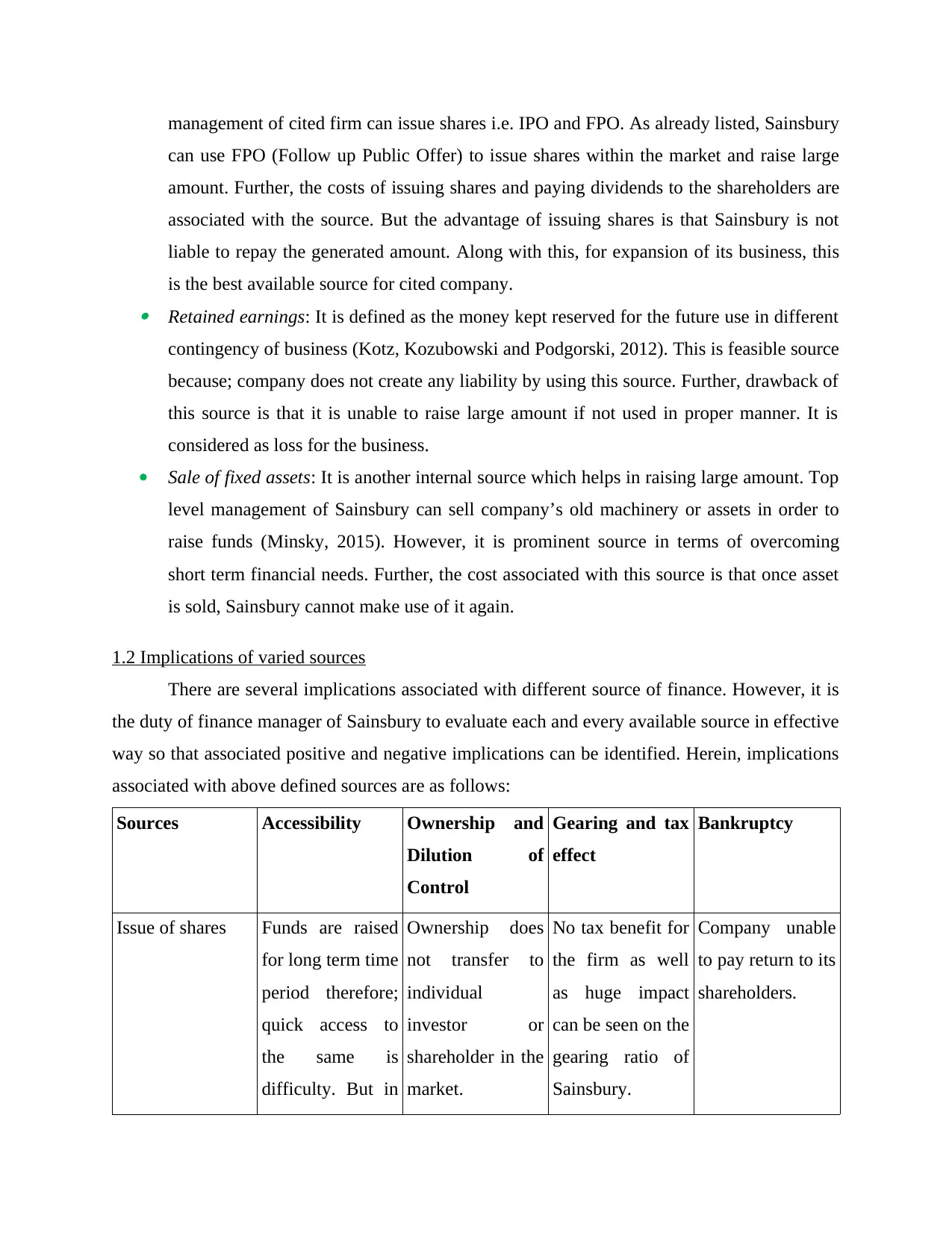
management of cited firm can issue shares i.e. IPO and FPO. As already listed, Sainsbury
can use FPO (Follow up Public Offer) to issue shares within the market and raise large
amount. Further, the costs of issuing shares and paying dividends to the shareholders are
associated with the source. But the advantage of issuing shares is that Sainsbury is not
liable to repay the generated amount. Along with this, for expansion of its business, this
is the best available source for cited company. Retained earnings: It is defined as the money kept reserved for the future use in different
contingency of business (Kotz, Kozubowski and Podgorski, 2012). This is feasible source
because; company does not create any liability by using this source. Further, drawback of
this source is that it is unable to raise large amount if not used in proper manner. It is
considered as loss for the business.
Sale of fixed assets: It is another internal source which helps in raising large amount. Top
level management of Sainsbury can sell company’s old machinery or assets in order to
raise funds (Minsky, 2015). However, it is prominent source in terms of overcoming
short term financial needs. Further, the cost associated with this source is that once asset
is sold, Sainsbury cannot make use of it again.
1.2 Implications of varied sources
There are several implications associated with different source of finance. However, it is
the duty of finance manager of Sainsbury to evaluate each and every available source in effective
way so that associated positive and negative implications can be identified. Herein, implications
associated with above defined sources are as follows:
Sources Accessibility Ownership and
Dilution of
Control
Gearing and tax
effect
Bankruptcy
Issue of shares Funds are raised
for long term time
period therefore;
quick access to
the same is
difficulty. But in
Ownership does
not transfer to
individual
investor or
shareholder in the
market.
No tax benefit for
the firm as well
as huge impact
can be seen on the
gearing ratio of
Sainsbury.
Company unable
to pay return to its
shareholders.
can use FPO (Follow up Public Offer) to issue shares within the market and raise large
amount. Further, the costs of issuing shares and paying dividends to the shareholders are
associated with the source. But the advantage of issuing shares is that Sainsbury is not
liable to repay the generated amount. Along with this, for expansion of its business, this
is the best available source for cited company. Retained earnings: It is defined as the money kept reserved for the future use in different
contingency of business (Kotz, Kozubowski and Podgorski, 2012). This is feasible source
because; company does not create any liability by using this source. Further, drawback of
this source is that it is unable to raise large amount if not used in proper manner. It is
considered as loss for the business.
Sale of fixed assets: It is another internal source which helps in raising large amount. Top
level management of Sainsbury can sell company’s old machinery or assets in order to
raise funds (Minsky, 2015). However, it is prominent source in terms of overcoming
short term financial needs. Further, the cost associated with this source is that once asset
is sold, Sainsbury cannot make use of it again.
1.2 Implications of varied sources
There are several implications associated with different source of finance. However, it is
the duty of finance manager of Sainsbury to evaluate each and every available source in effective
way so that associated positive and negative implications can be identified. Herein, implications
associated with above defined sources are as follows:
Sources Accessibility Ownership and
Dilution of
Control
Gearing and tax
effect
Bankruptcy
Issue of shares Funds are raised
for long term time
period therefore;
quick access to
the same is
difficulty. But in
Ownership does
not transfer to
individual
investor or
shareholder in the
market.
No tax benefit for
the firm as well
as huge impact
can be seen on the
gearing ratio of
Sainsbury.
Company unable
to pay return to its
shareholders.
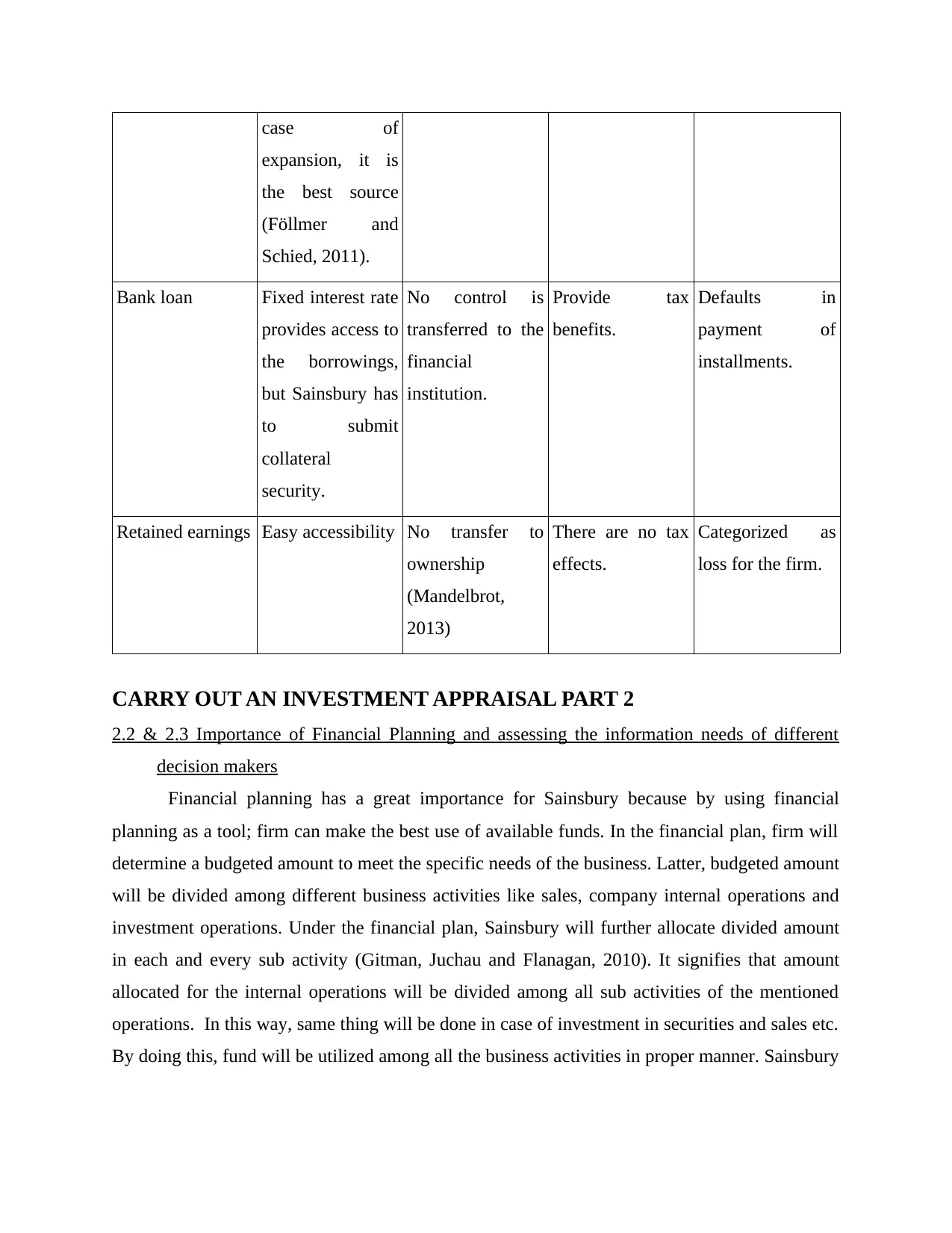
case of
expansion, it is
the best source
(Föllmer and
Schied, 2011).
Bank loan Fixed interest rate
provides access to
the borrowings,
but Sainsbury has
to submit
collateral
security.
No control is
transferred to the
financial
institution.
Provide tax
benefits.
Defaults in
payment of
installments.
Retained earnings Easy accessibility No transfer to
ownership
(Mandelbrot,
2013)
There are no tax
effects.
Categorized as
loss for the firm.
CARRY OUT AN INVESTMENT APPRAISAL PART 2
2.2 & 2.3 Importance of Financial Planning and assessing the information needs of different
decision makers
Financial planning has a great importance for Sainsbury because by using financial
planning as a tool; firm can make the best use of available funds. In the financial plan, firm will
determine a budgeted amount to meet the specific needs of the business. Latter, budgeted amount
will be divided among different business activities like sales, company internal operations and
investment operations. Under the financial plan, Sainsbury will further allocate divided amount
in each and every sub activity (Gitman, Juchau and Flanagan, 2010). It signifies that amount
allocated for the internal operations will be divided among all sub activities of the mentioned
operations. In this way, same thing will be done in case of investment in securities and sales etc.
By doing this, fund will be utilized among all the business activities in proper manner. Sainsbury
expansion, it is
the best source
(Föllmer and
Schied, 2011).
Bank loan Fixed interest rate
provides access to
the borrowings,
but Sainsbury has
to submit
collateral
security.
No control is
transferred to the
financial
institution.
Provide tax
benefits.
Defaults in
payment of
installments.
Retained earnings Easy accessibility No transfer to
ownership
(Mandelbrot,
2013)
There are no tax
effects.
Categorized as
loss for the firm.
CARRY OUT AN INVESTMENT APPRAISAL PART 2
2.2 & 2.3 Importance of Financial Planning and assessing the information needs of different
decision makers
Financial planning has a great importance for Sainsbury because by using financial
planning as a tool; firm can make the best use of available funds. In the financial plan, firm will
determine a budgeted amount to meet the specific needs of the business. Latter, budgeted amount
will be divided among different business activities like sales, company internal operations and
investment operations. Under the financial plan, Sainsbury will further allocate divided amount
in each and every sub activity (Gitman, Juchau and Flanagan, 2010). It signifies that amount
allocated for the internal operations will be divided among all sub activities of the mentioned
operations. In this way, same thing will be done in case of investment in securities and sales etc.
By doing this, fund will be utilized among all the business activities in proper manner. Sainsbury
⊘ This is a preview!⊘
Do you want full access?
Subscribe today to unlock all pages.

Trusted by 1+ million students worldwide
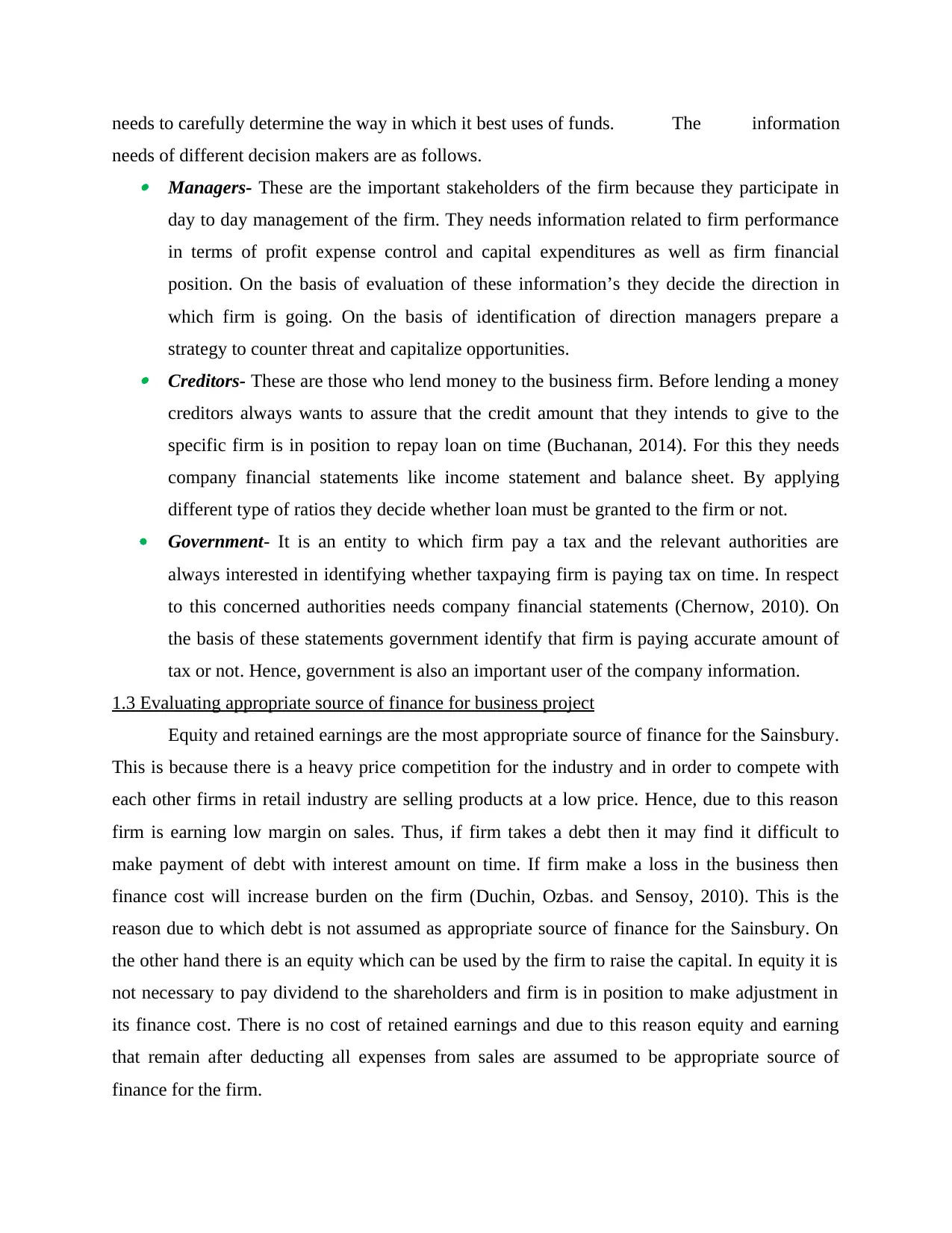
needs to carefully determine the way in which it best uses of funds. The information
needs of different decision makers are as follows. Managers- These are the important stakeholders of the firm because they participate in
day to day management of the firm. They needs information related to firm performance
in terms of profit expense control and capital expenditures as well as firm financial
position. On the basis of evaluation of these information’s they decide the direction in
which firm is going. On the basis of identification of direction managers prepare a
strategy to counter threat and capitalize opportunities. Creditors- These are those who lend money to the business firm. Before lending a money
creditors always wants to assure that the credit amount that they intends to give to the
specific firm is in position to repay loan on time (Buchanan, 2014). For this they needs
company financial statements like income statement and balance sheet. By applying
different type of ratios they decide whether loan must be granted to the firm or not.
Government- It is an entity to which firm pay a tax and the relevant authorities are
always interested in identifying whether taxpaying firm is paying tax on time. In respect
to this concerned authorities needs company financial statements (Chernow, 2010). On
the basis of these statements government identify that firm is paying accurate amount of
tax or not. Hence, government is also an important user of the company information.
1.3 Evaluating appropriate source of finance for business project
Equity and retained earnings are the most appropriate source of finance for the Sainsbury.
This is because there is a heavy price competition for the industry and in order to compete with
each other firms in retail industry are selling products at a low price. Hence, due to this reason
firm is earning low margin on sales. Thus, if firm takes a debt then it may find it difficult to
make payment of debt with interest amount on time. If firm make a loss in the business then
finance cost will increase burden on the firm (Duchin, Ozbas. and Sensoy, 2010). This is the
reason due to which debt is not assumed as appropriate source of finance for the Sainsbury. On
the other hand there is an equity which can be used by the firm to raise the capital. In equity it is
not necessary to pay dividend to the shareholders and firm is in position to make adjustment in
its finance cost. There is no cost of retained earnings and due to this reason equity and earning
that remain after deducting all expenses from sales are assumed to be appropriate source of
finance for the firm.
needs of different decision makers are as follows. Managers- These are the important stakeholders of the firm because they participate in
day to day management of the firm. They needs information related to firm performance
in terms of profit expense control and capital expenditures as well as firm financial
position. On the basis of evaluation of these information’s they decide the direction in
which firm is going. On the basis of identification of direction managers prepare a
strategy to counter threat and capitalize opportunities. Creditors- These are those who lend money to the business firm. Before lending a money
creditors always wants to assure that the credit amount that they intends to give to the
specific firm is in position to repay loan on time (Buchanan, 2014). For this they needs
company financial statements like income statement and balance sheet. By applying
different type of ratios they decide whether loan must be granted to the firm or not.
Government- It is an entity to which firm pay a tax and the relevant authorities are
always interested in identifying whether taxpaying firm is paying tax on time. In respect
to this concerned authorities needs company financial statements (Chernow, 2010). On
the basis of these statements government identify that firm is paying accurate amount of
tax or not. Hence, government is also an important user of the company information.
1.3 Evaluating appropriate source of finance for business project
Equity and retained earnings are the most appropriate source of finance for the Sainsbury.
This is because there is a heavy price competition for the industry and in order to compete with
each other firms in retail industry are selling products at a low price. Hence, due to this reason
firm is earning low margin on sales. Thus, if firm takes a debt then it may find it difficult to
make payment of debt with interest amount on time. If firm make a loss in the business then
finance cost will increase burden on the firm (Duchin, Ozbas. and Sensoy, 2010). This is the
reason due to which debt is not assumed as appropriate source of finance for the Sainsbury. On
the other hand there is an equity which can be used by the firm to raise the capital. In equity it is
not necessary to pay dividend to the shareholders and firm is in position to make adjustment in
its finance cost. There is no cost of retained earnings and due to this reason equity and earning
that remain after deducting all expenses from sales are assumed to be appropriate source of
finance for the firm.
Paraphrase This Document
Need a fresh take? Get an instant paraphrase of this document with our AI Paraphraser

2.4 Impact of finance on the financial statements
Finance to large extent affects financial statements of the firm. Under this, Sainsbury can
either raise a fund through issue of equity or taking debt from the banks. In both cases firm
income statement and balance sheet will get affected. If shares are issued then liability side of the
balance sheet wil get increased because capital that is raised though equity will be mentioned
under head shareholder equity which is included in the liability (Hyman, 2013). Thus, due to
this reaosn liability side of the balance sheet will get increased. By same amount cash in the
assets side of the balance sheet will increase. At the end of the year divided is if declared then
that amount will be entered in to income statement and will be deducted from the gross profit.
Hence, issue of shares will bring changes in the income statement. Similarly, if debt is taken
from the banks then cash side of the balance sheet will increased and long term liability amount
in the liability side of the balance sheet will also increased. Hence, in this balance sheet both
sides will match to each other (Shahrokhi, 2008). Interest that is paid on loan will be entered in
to income statement. Hence, profit of the firm will be reduced by the interest amount. Hence,
both source of finance affects financial statements of the Sainsbury.
4.2 & 4.2 discussing the main financial statements ad comparing their formats
The main financial statements of the firm are as follows. Income statement- It is a statement that reflect the income earned by the firm and cost it
incurred to earn specific amount of profit and revenue. It is a statement that also reflects
that firm is successfully controlling its expenses or not. In other words, it can be said that
on the basis of this statement managers identify the areas where firm makes an
extravagance (Shaoul, Stafford and Stapleton, 2010). Hence, managers form a strategy in
order to make sure that such will not be made again. Balance sheet- It is a statement that reflects the firm financial position at the end of the
financial year. Managers use ratio analysis method in order to evaluate Sainsbury
performance from various angels. They prepare a strategy that can be employed in order
to improve values in the balance sheet. By doing so managers try to make company
financial position stronger than before.
Cash flow statement- It is a statement that reflects the cash inflow and outflow that is
happening in the operating, investing and finance activities of the firm (Pacini, Qiu and
Sinason, 2007). In this statement all non cash items are added back and an attempt is
Finance to large extent affects financial statements of the firm. Under this, Sainsbury can
either raise a fund through issue of equity or taking debt from the banks. In both cases firm
income statement and balance sheet will get affected. If shares are issued then liability side of the
balance sheet wil get increased because capital that is raised though equity will be mentioned
under head shareholder equity which is included in the liability (Hyman, 2013). Thus, due to
this reaosn liability side of the balance sheet will get increased. By same amount cash in the
assets side of the balance sheet will increase. At the end of the year divided is if declared then
that amount will be entered in to income statement and will be deducted from the gross profit.
Hence, issue of shares will bring changes in the income statement. Similarly, if debt is taken
from the banks then cash side of the balance sheet will increased and long term liability amount
in the liability side of the balance sheet will also increased. Hence, in this balance sheet both
sides will match to each other (Shahrokhi, 2008). Interest that is paid on loan will be entered in
to income statement. Hence, profit of the firm will be reduced by the interest amount. Hence,
both source of finance affects financial statements of the Sainsbury.
4.2 & 4.2 discussing the main financial statements ad comparing their formats
The main financial statements of the firm are as follows. Income statement- It is a statement that reflect the income earned by the firm and cost it
incurred to earn specific amount of profit and revenue. It is a statement that also reflects
that firm is successfully controlling its expenses or not. In other words, it can be said that
on the basis of this statement managers identify the areas where firm makes an
extravagance (Shaoul, Stafford and Stapleton, 2010). Hence, managers form a strategy in
order to make sure that such will not be made again. Balance sheet- It is a statement that reflects the firm financial position at the end of the
financial year. Managers use ratio analysis method in order to evaluate Sainsbury
performance from various angels. They prepare a strategy that can be employed in order
to improve values in the balance sheet. By doing so managers try to make company
financial position stronger than before.
Cash flow statement- It is a statement that reflects the cash inflow and outflow that is
happening in the operating, investing and finance activities of the firm (Pacini, Qiu and
Sinason, 2007). In this statement all non cash items are added back and an attempt is
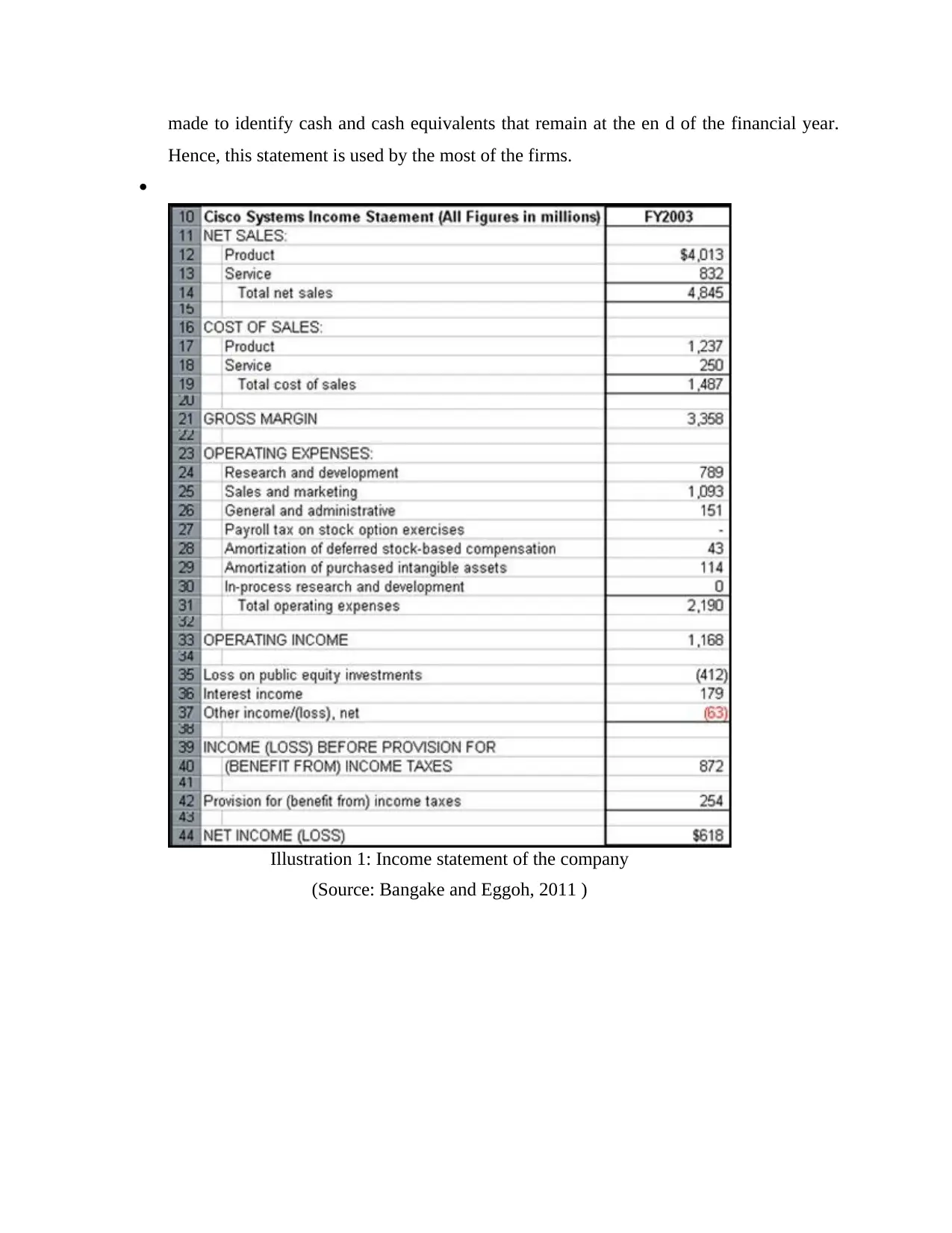
made to identify cash and cash equivalents that remain at the en d of the financial year.
Hence, this statement is used by the most of the firms.
Illustration 1: Income statement of the company
(Source: Bangake and Eggoh, 2011 )
Hence, this statement is used by the most of the firms.
Illustration 1: Income statement of the company
(Source: Bangake and Eggoh, 2011 )
⊘ This is a preview!⊘
Do you want full access?
Subscribe today to unlock all pages.

Trusted by 1+ million students worldwide
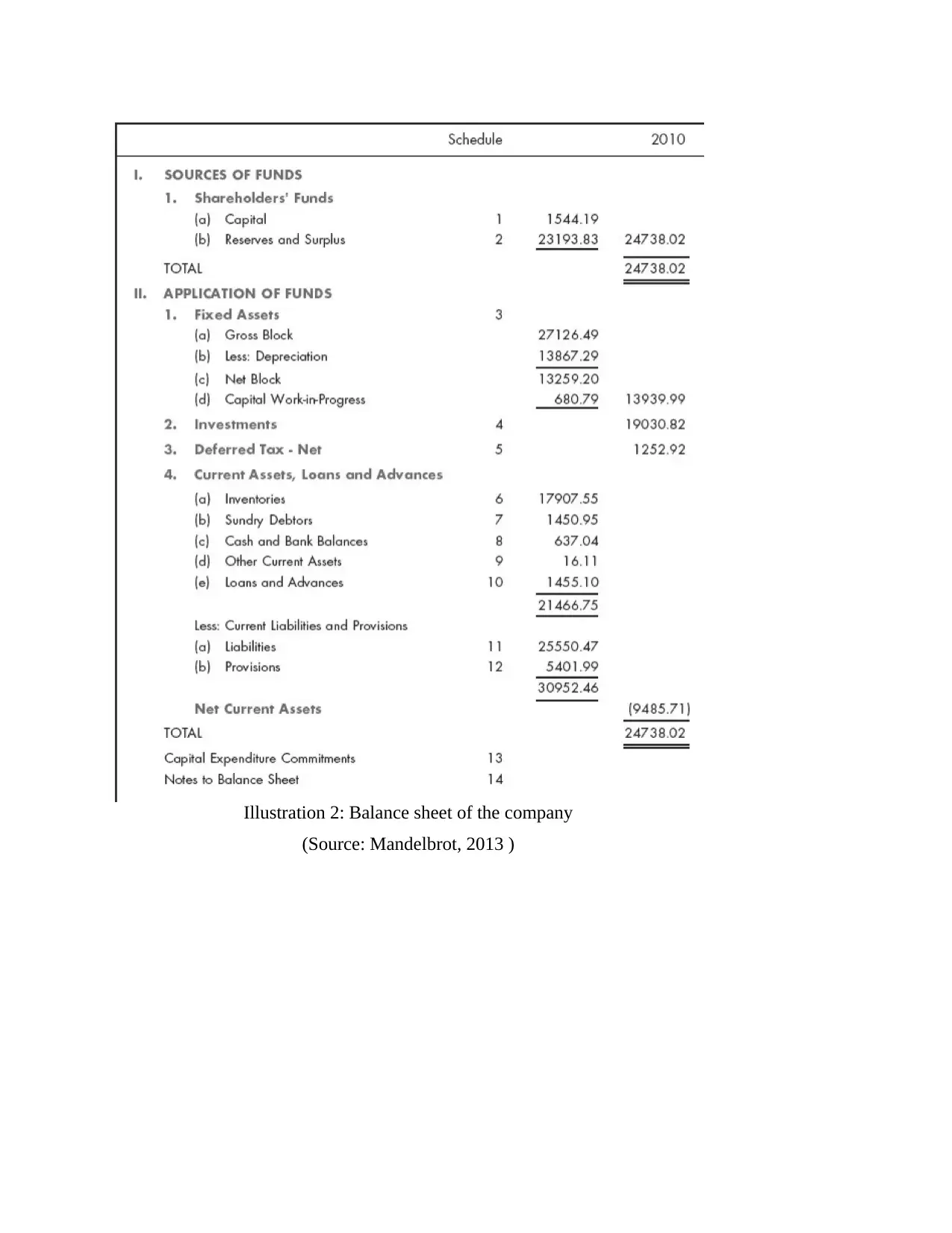
Illustration 2: Balance sheet of the company
(Source: Mandelbrot, 2013 )
(Source: Mandelbrot, 2013 )
Paraphrase This Document
Need a fresh take? Get an instant paraphrase of this document with our AI Paraphraser

Illustration 3: Cash flow statement of the company
(Source:Chernow, 2010 )
(Source:Chernow, 2010 )

Sole trader
Illustration 4: Income statement of sole trader
(Source:Duchin, R., Ozbas and Sensoy, , 2010 )
Illustration 4: Income statement of sole trader
(Source:Duchin, R., Ozbas and Sensoy, , 2010 )
⊘ This is a preview!⊘
Do you want full access?
Subscribe today to unlock all pages.

Trusted by 1+ million students worldwide
1 out of 23
Related Documents
Your All-in-One AI-Powered Toolkit for Academic Success.
+13062052269
info@desklib.com
Available 24*7 on WhatsApp / Email
![[object Object]](/_next/static/media/star-bottom.7253800d.svg)
Unlock your academic potential
Copyright © 2020–2025 A2Z Services. All Rights Reserved. Developed and managed by ZUCOL.





